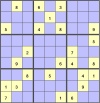Strategies for Defensive Play
Menu

Play Sudoku

Fish Database

Bird Database

Plant Database
Introduction
The defensive play is probably the part of bridge that requires the most skill. You have just a little information from the bidding about your partners hand as well as declarers hand and you can see the dummy (after the first card has been played). A lot of good defensive play involves playing your cards in exactly the same way that declarer would to maximize their trick, except as defence you can't see exactly which cards your partner holds, so you need to use a lot of intuition, keep good count of the cards played, learn to follow partners signals. Fortunately there are some golden rules that get you started, so you can get started quickly and learn the more complex rules of good play as you go along.
One of the most important parts of play is to keep count of the cards. In many cases, the last few tricks can be critical, with declarer hoping that you are forced to guess which cards to discard. Careful card counting will help you to make better decisions.
Probably the most important card played by defence is the very first card on the table. There are plenty of rules to help you decide, which card is likely to be a good one, though in many cases it comes down to choosing the lesser of two evils!
Much of the defensive play in WolfBridge has been taken from the book "Guide to better card play" by Ron Klinger. This book is easy to read and has very good explanations of all of the rules defined. Another book that was used as a reference is "The Golden Rules of Defence" by Julian Pottage. I would recommend that book to the advanced player, as you need a thorough understanding of the bidding and various standard leads and signalling in order to be able to understand the examples.
Golden Rules
The following rules are just a starting point. They are rules because in the majority of hands they give the best percentage chance of making the most tricks, but there are many exceptions to these rules.
- Third Hand High
- Second Hand Low
- Lead up to weakness
- Lead through strength
Counting the cards
Counting the cards is an essential part of planning a good defence. It's very difficult to remember exactly which cards have been played in every trick and for beginners it's difficult to remember even how many trump cards have gone. A method that helps here, is to try to remember how many rounds of a particular suit have been played. Since there are alway four cards in a trick, then you just have to remember if anyone discarded on any of those rounds to be able to work out how many cards of that suit have been played. Say there have been two rounds of trump and your partner discarded from another suit on the second round, then you know that 7 trump have been played. Looking at the number of trump in your hand and the number in dummy, you can now calculate exactly how many the declarer is still holding and if you can remember which values have been played, you will know their exact holding. Since you spend quite a long time analysing your own hand during the auction, it's generally quite easy to remember how many rounds of each suit have gone, because you should be able to remember how cards of each suit you held at the beginning!
Don't forget to use the information provided by the bidding when counting cards. If declarer opened with a suit at the one level, remember that means that they have at least four cards in that suit. If your partner put in an intervening bid of another suit, that indicates a holding of five cards in their suit.
The negative information can be just as useful as the positive information. If your partner intervened with a bid in hearts and no hearts have been played right up till the last five tricks, then don't expect your partner to be holding that vital ace of diamonds! If one of the declarers opened with a major suit, yet they ended up in a minor suit, it is very unlikely that the openers partner holds four or more of that major suit!
Leading in No Trump
The general rule about leading in No Trump, is to lead from your partnerships longest, strongest suit. With no information from the bidding about your partners hand, this is generally then your own longest, strongest suit.
It is normal practise to lead the fourth highest card from your longest, strongest suit. Though there are plenty of exceptions. The most common exception is when you hold a solid sequence. A solid sequence is an unterrupted sequence of three cards, whereby the top card is an hnnour. For example K,Q,J or 10,9,8. (10 is counted as an honour).
If your partner indicated a long suit, by an intervening bid, you should generally lead this suit, unless you yourself hold a long, strong suit. You would need at least a five card suit, headed by a couple of honour cards to consider leading your own suit before partners bid suit.
Leading in a Suit Contract
The lead in a suit contract is not so easy. Basically you should lead your partners suit (if they bid) unless you think your partnership holds 10 or more of the cards in that suit (you would be likely to give away a ruff immediately in that case). If your partner did not bid then you should try to avoid leading the oppositions suits.
Of the unbid suits, any suit with a solid sequence, or a partial sequence is better than a suit headed by a single honour. Leading from rags is also better than leading from a suit with a single honour.
If you are left with having to lead from an Axxx holding, play the ace.
Setting up a Suit
This generally applies to playing in No Trump, but also applies to playing in a suit contract to some extent, because once the trumps have all gone you are now effectively playing in No Trump.
The idea of setting up a suit, is to try to make the low cards in your longest suit into winners. You might look at a holding of J,10,9,8,7,x,x and think that it's not going to be of much use, because you're bound to lose three tricks to the A,K and Q. The point here is, that once you've lost say the J,10 and 9, your 8,7,x,x are now all winners, as long as you can get to lead them. In order to be able to lead them, you need to win a trick in another suit (the previous three rounds of your suit will almost certainly have removed any possilibily of your partner leading this suit back to you). This means that you need to start taking out the A,K and Q, before you use your winners in other suits.
Side suit entries are often the key issue in being able to set up a suit. If you don't hold enough entries into your hand in order to be able to play your suit enough times till you have succesfully set it up, then you might as well ignore this suit and try to work out which suit your partner might be able to set up themselves.
Cross Ruffing
Cross ruffing occurs on strange distributions. If you hold a long suit that your partner is void in and they hold a suit that you are void in and you both hold trump cards, then you can play your suit across to your partner who ruffs it and they then play their suit back to be ruffed by you. This can bring down a contract that would otherwise have made, if the declarer had been able to get on lead and take out your trumps.
Cross ruffing is a game that can be played by either side. If you suspect that the declarer is planning on making a lot of tricks by cross-ruffing, you are often best off leading trumps in order to reduce the number of times they can cross-ruff.
If it's obvious that the dummy has a shorter holding in trumps than declarer and there is a void or a singleton in dummy, then it's quite likely that declarer will want to ruff from dummy at some point, so here again is a good reason for leading trumps.
Signalling
Signalling is a method of passing information based on exactly which card you discard. You can signal when following suit or when discarding another suit.
There are many different standards for signalling, so you need to be clear with your partner in advance as to which methods of signalling you use.
As an example, when following suit after a lead by your partner, some players will throw a larger value card than necessary as a discard in order to encourage you to lead this suit. It is important not to throw away a card that is likely to be useful as a winner later, just in order to signal. For that reason it is very unusual to signal with anything higher than a 9. When playing using this signal, obviously when partner throws their smallest card away, this is discouraging the suit.
After a lead by the declarer, many partnerships play suit preference signals, whereby a high discard indicates that you prefer a high suit and a low discard indicates a low suit. The reason for this, is that you wouldn't normally be interested in the suit that the declarer is attacking.
Other forms of signalling are more complex and can give an indication to your partner as to the number of cards you hold in that suit.
Unblocking
Unblocking a suit is obvious when playing as the declarer and you can easily see how a particular order of playing your hands can leave you on lead in the wrong hand, but it's not so obvious when playing defence, though the same rule applies.
If you were lucky enough to hold Ax, when your partner leads the K, how many times would you duck with the x thinking that you don't want to waste your A on your partners K, which is winning the trick anyway? In a No Trump contract, the lead of K by your partner is a strong indication that they hold K,Q,J,x,x, or K,Q,10,x,x! As soon as you know that, then it's obvious that you need beat the K with your A so that you can lead back your x and your partner can take all their tricks in that suit.
There are naturally exceptions to this. For example if you were in 6NT and it turned out that your partner did not hold the Q, then by playing your A on the K you might have wasted a trick that could have brought the contract down.
Further reading
Some useful tips can be found at the following web sites:
